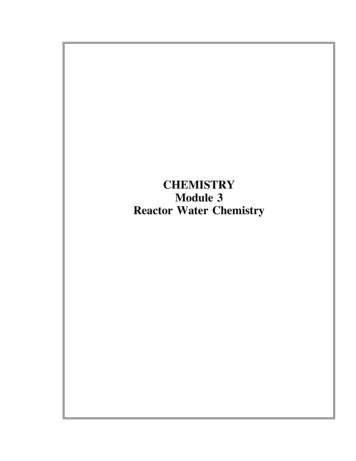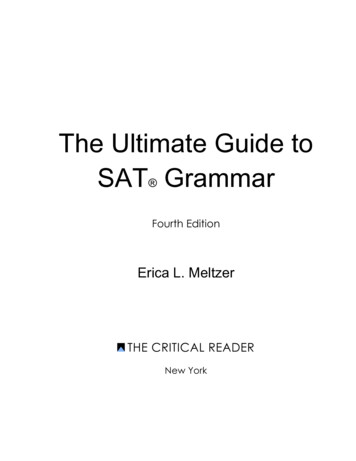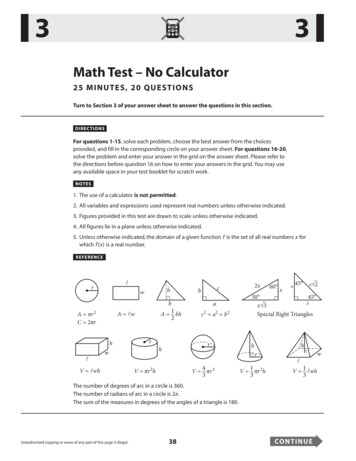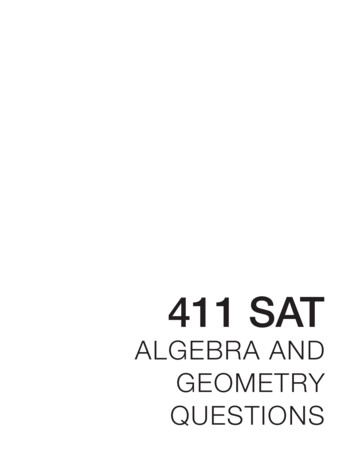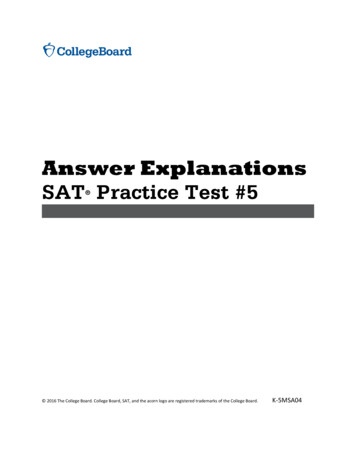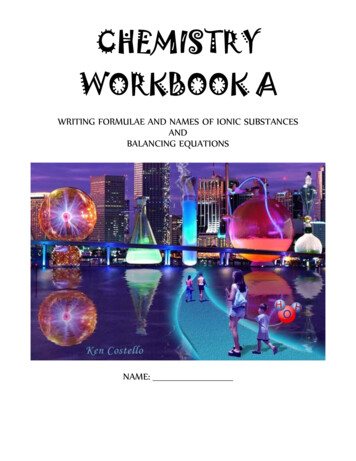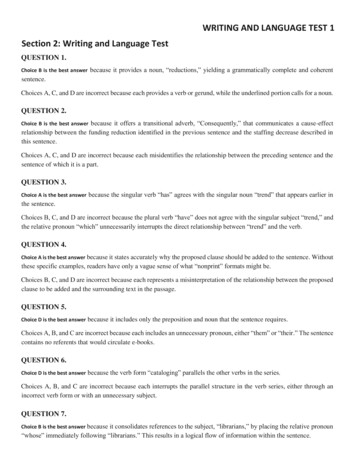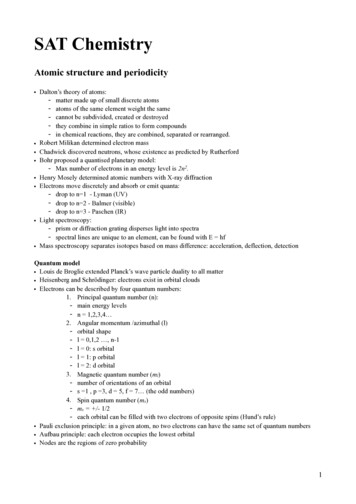
Transcription
SAT ChemistryAtomic structure and periodicity Dalton’s theory of atoms:- matter made up of small discrete atoms- atoms of the same element weight the same- cannot be subdivided, created or destroyed- they combine in simple ratios to form compounds- in chemical reactions, they are combined, separated or rearranged. Robert Milikan determined electron mass Chadwick discovered neutrons, whose existence as predicted by Rutherford Bohr proposed a quantised planetary model:- Max number of electrons in an energy level is 2n2. Henry Mosely determined atomic numbers with X-ray diffraction Electrons move discretely and absorb or emit quanta:- drop to n 1 - Lyman (UV)- drop to n 2 - Balmer (visible)- drop to n 3 - Paschen (IR)Lightspectroscopy: - prism or diffraction grating disperses light into spectra- spectral lines are unique to an element, can be found with E hf Mass spectroscopy separates isotopes based on mass difference: acceleration, deflection, detectionQuantum model Louis de Broglie extended Planck’s wave particle duality to all matter Heisenberg and Schrödinger: electrons exist in orbital clouds Electrons can be described by four quantum numbers:1. Principal quantum number (n):- main energy levels- n 1,2,3,4 2. Angular momentum /azimuthal (l)- orbital shape- l 0,1,2 , n-1- l 0: s orbital- l 1: p orbital- l 2: d orbital3. Magnetic quantum number (ml)- number of orientations of an orbital- s 1 , p 3, d 5, f 7 (the odd numbers)4. Spin quantum number (ms)- ms /- 1/2- each orbital can be filled with two electrons of opposite spins (Hund’s rule) Pauli exclusion principle: in a given atom, no two electrons can have the same set of quantum numbers Aufbau principle: each electron occupies the lowest orbital Nodes are the regions of zero probability!1
Periodicity Chromium: [Ar] 4s1 3d5. Copper: [Ar] 4s1 3d10. Lowest electronegativity highest desire to lose electronBonding and Chemical Formulae If E.N 1.7, ionic.If 0.4 E.N 1.6, then polar covalentWhen a covalent bond forms, there is minimum potential energy between atomsHybridisation and VSEPR are two theories to predict shapes.Molecules with eight electron pairs have sp3d2 hybridisation.For ions with oxygen:- hypo- one oxygen (or fewest number of oxygens)- -ite fewer oxygens- -ate more oxygens- per- most oxygensFor naming acids:- If there is no oxygen, then it is hydro- If the acid anion is an -ate, then the acid will be -ic e.g sulphuric acid- If the acid anion is an -ite, then it will be -ous e.g sulphurous acidAn acid anhydride is a nonmetal oxide which reacts with water to form an acidic solutionLaw of Multiple Proportions - two elements can sometimes combine in different small-whole-numberratios1Formal charge V N bonding N nonbondingThe formal charge formula is:2where V is the number of valence electrons.Gases and the gas laws To prepare oxygen, we heat potassium chlorate with a manganese dioxide catalyst:! 2KClO3 2KCl 3O2 Hydrogen is normally produced by electrolysis, passing steam over coke, or cracking hydrocarbons 1 atm 760mmHg 760 torr 101.325kPa Effusion - passage of gas through small hole into empty chamber.Gas laws Graham’s Law of Effusion:- The rate of effusion: ! rate M R Gay-Lussac’s law pressure law. Dalton’s law of partial pressures:- When a gas is made up of a mixture of different gases, the total pressure is the sum of the partialpressures, where the partial pressure is the pressure that the gas would make if it were alone:Ptotal Pgas1 Pgas 2 Pgas3 . When a gas is collected over a volatile liquid, you must subtract the vapour pressure: Pgas Patm PH 2O Since mercury is 13.6 times heavier than water, the height of mercury in a eudiometer will be 1/13.6 theheight of water.!2
For the Ideal Gas Law,R 0.0821L atmmol kPM density: ρ RT At high pressures or low temperatures, molecules get closer so attractive forces come into play - hencevolume is lower than ideal gas law predict Gay-Lussac’s law (another one):- the ratio between the volumes of the reactant gases and the products can be expressed in simple wholenumbers.Liquids, solids and phase changes Above the critical temperature, the liquid phase ofa substance cannot exist. At critical temperature, critical temperature isrequired to liquefy the gas. Amorphous solids have a random structure Polycrystalline solids have a large number ofcrystals arranged randomly. For solids, solubility increases with temperature(opposite in gases) The solubility of gas in liquid is directlyproportional to the gas pressure (Henry’s law). Water mixtures can be solutions (particles smallerthan 1nm), suspensions (greater than 1000nm) orcolloids (in between). Saturated solutions are in equilibrium. Molality is the number of moles per 1000 grams of solvent. The freezing point of a substance decreases 1.86K per molality of solute per mole of solute particles, theboiling point increases by 0.51K. Hydrates that lose water of hydration are efflorescent Hydrates that absorb water are deliquescent or hydroscopic e.g calcium chloride. Osmotic pressure is proportional to molarity (M). MRT.Chemical reactions and equilibria For double replacement reactions to go to completion, one of the following must be formed- insoluble precipitate!3
- nonionising substance- gaseous product given off Since energy is conserved (First law of thermodynamics), we can add enthalpies e.g in Hess’s law. The overall change in entropy is positive.ΔG ΔH T ΔS The Law of Mass Action states that for a reaction between A and B, aA bB , the rate expression is:r [ A]a [B]b or r k[ A]a [B]b where k is the specific rate constant.Equilibria A saturated solution of a substance has an equilibrium e.g AgCl ! Ag Cl The solubility constant:K sp [ Ag ][Cl ]ΔG nFEcell RT ln K eq If predicted concentrations are too large, precipitates form The common ion effect states that a large increase in ions on one side of an equilibrium may cause somesubstance to move out of solution ΔG / RT The equilibrium constant K depends on the Gibbs free energy: k eAcids and bases Conjugate base is an acid minus H. Strong acid weak conjugate base. pH pOH 14 Buffers are weak acids and their conjugate base. Metallic oxides can react with nonmetallic oxides. The normality of a solution regards the number of number of mole equivalents of H . The gram equivalent weight is how much of the acid solution is needed to release the equivalent H Organic chemistry For cycloalkanes, assign position 1 to the alkyl that comes first inalphabetical order then give the rest the lowest numbers possible. The aromatic groups are unsaturated ringstructures, the general formula is ! C6 H 2n 6 . Thesimplest is benzene (C6H6). The phenyls are C6H5, groups can then beadded, e.g methyl benzene toulene. Different benzene substitutions have differentisomer forms, ortho, meta and para.!4
Practical chemistry Some precise tools are:- Gravimetric balances with readings to thousandths of a gram- pH meters- Spectrophotometers (percentage of light transmitted through a substance - determines molality)Tests for substances Ammonia - expose to HCl fumes - NH4CL (white solid) forms HCl - exhale over gas, vapour fumes Hydrogen sulfide turns led acetate paper brown black Oxygen - add nitric oxide gas, turns red-brown Acetate - add sulphuric acid and warm - vinegar odour. Sulphate - add BaCl2 then HCL - white precipitate forms Ammonium - add strong base and heat - ammonia released Fe 2/3, potassium ferricyanide/ferrocyanide then dark blue precipitate Flame tests:- sodium - yelow- Potassium - violet- Lithium - crimson- calcium - orange-red- barium - green- strontium - bright red Hydrogen sulfide tests:- lead - brown black- copper -black- silver - black- mercury - black- nickel - black- iron - black- cadmium - yellow- arsenic - yellow- antimony - orange- zinc - white- bismuth -brown.!5
SAT Chemistry Atomic structure and periodicity Dalton’s theory of atoms: -matter made up of small discrete atoms -atoms of the same element weight the same -cannot be subdivided, created or destroyed -they combine in simple ratios to form compounds -in chemical reactions, they are combined, separated or rearranged. Robert Milikan determined electron mass

